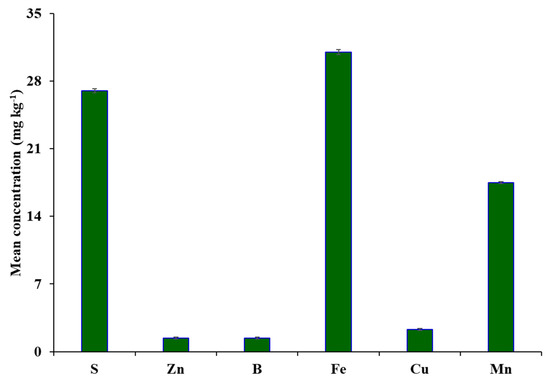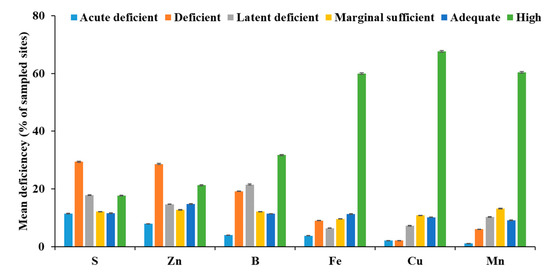3. Distribution of Single Nutrient Deficiencies of S, Zn, B, Fe, Cu and Mn
The concentration of available nutrients in soils were grouped into acute deficient, deficient, latent deficient, marginally sufficient, adequate and high categories. About 11.4%, 29.4% and 17.8% of the sampled sites were acute deficient (≤7.5 mg kg−1), deficient (>7.5–≤15.0 mg kg−1) and latent deficient (>15.0–≤22.5 mg kg−1) in available S, respectively (Figure 2). Meanwhile, 12.1%, 11.6% and 17.7% of the sampled sites were marginally sufficient (>22.5–≤30.0 mg kg−1), adequate (>30.0–≤40.0 mg kg−1) and high (>40.0 mg kg−1) in available S. Out of 615 districts, >30–≤40% of the sampled sites in 86 districts, >40–≤50% of the sampled sites in 70 districts and >50% of the sampled sites in 101 districts were deficient (acute deficient + deficient) in available S. More than 50% of the sampled sites in 12 districts of Gujarat, 13 districts of Madhya Pradesh and 8 districts each in Odisha and Tamil Nadu were deficient in available S.
Figure 2. Mean deficiency of available S and micronutrients in agricultural soils of India. Error bars indicate stand error of the means.
About 7.90%, 28.6% and 14.7% of the sampled sites were acute deficient (≤0.30 mg kg−1), deficient (>0.30–≤0.60 mg kg−1) and latent deficient (>0.60–≤0.90 mg kg−1) in available Zn, respectively (Figure 2). Meanwhile, 12.7%, 14.8% and 21.3% of the sampled sites were marginally sufficient (>0.90–≤1.20 mg kg−1), adequate (>1.20–≤1.80 mg kg−1) and high (>1.80 mg kg−1) in available Zn, respectively. More than 30–≤40% of the sampled sites in 68 districts, >40–≤50% of samples in 57 districts and >50% of the sampled sites in 131 districts were deficient (acute deficient + deficient) in available Zn. More than 50% of the sampled sites in 16 districts of Bihar, 40 districts of Madhya Pradesh, 13 districts of Maharashtra and 23 districts of Tamil Nadu were deficient in available Zn.
About 4.00%, 19.2% and 21.5% of the sampled sites were acute deficient (≤0.20 mg kg−1), deficient (>0.20–≤0.50 mg kg−1) and latent deficient (>0.50–≤0.70 mg kg−1) in available B, respectively (Figure 2). Meanwhile, 12.1%, 11.4% and 31.7% of the sampled sites were marginally sufficient (>0.70–≤0.90 mg kg−1), adequate (>0.90–≤1.10 mg kg−1) and high (>1.10 mg kg−1) in available B, respectively. More than 30–≤40% of the sampled sites in 75 districts, >40–≤50% of the sampled sites in 57 districts and >50% of the sampled sites in 86 districts were deficient (acute deficient + deficient) in available B. More than 50% of the sampled sites in 6 districts each of Assam and Karnataka, 7 districts of Jharkhand, 10 districts of Kerala, 15 districts of Odisha and 5 districts each of Maharashtra, Telangana and West Bengal were deficient in available B.
About 3.80%, 9.00% and 6.40% of the sampled sites were acute deficient (≤2.50 mg kg−1), deficient (>2.50–≤4.50 mg kg−1) and latent deficient (>4.50–≤6.50 mg kg−1) in available Fe, respectively (Figure 2). Meanwhile, 9.60%, 11.3% and 59.9% of the sampled sites were marginally sufficient (>6.50–≤8.50 mg kg−1), adequate (>8.50–≤10.5 mg kg−1) and high (>10.5 mg kg−1) in available Fe, respectively. More than 15–≤20% of the sampled sites in 55 districts, >20–≤25% of samples in 17 districts and >25% of the sampled sites in 83 districts were deficient (acute deficient + deficient) in available Fe. More than 25% of the sampled sites in 17 districts of Gujarat, 14 districts of Maharashtra, 8 districts of Rajasthan and 9 districts of Uttar Pradesh were deficient in available Fe.
About 2.10%, 2.10% and 7.20% of the sampled sites were acute deficient (≤0.20 mg kg−1), deficient (>0.20–≤0.40 mg kg−1) and latent deficient (>0.40–≤0.60 mg kg−1) in available Cu, respectively (Figure 2). Meanwhile, 10.8%, 10.2% and 67.6% of the sampled sites were marginally sufficient (>0.60–≤0.80 mg kg−1), adequate (>0.80–≤1.00 mg kg−1) and high (>1.00 mg kg−1) in available Cu. Out of 615 districts, >15–≤20% of the sampled sites in 13 districts, >20–≤25% of the sampled sites in 8 districts and >25% of the sampled sites in 5 districts were deficient (acute deficient + deficient) in available Cu. More than 25% of the sampled sites in one district of Haryana, three districts of Tamil Nadu and one district of Odisha were deficient in available Cu.
About 1.10%, 6.00% and 10.3% of the sampled sites were acute deficient (≤1.00 mg kg−1), deficient (>1.00–≤3.00 mg kg−1) and latent deficient (>3.00–≤5.00 mg kg−1) in available Mn, respectively (Figure 2). Meanwhile, 13.2%, 9.10% and 60.4% of the sampled sites were marginally sufficient (>5.00–≤7.00 mg kg−1), adequate (>7.00–≤9.00 mg kg−1) and high (>9.00 mg kg−1) in available Mn, respectively. More than 15–≤20% of the sampled sites in 21 districts, >20–≤25% of samples in 14 districts and >25% of the sampled sites in 41 districts were deficient (acute deficient + deficient) in available Mn. More than 25% of the sampled sites in 4 districts of Bihar, 7 districts each of Jammu and Kashmir, Punjab and Rajasthan, 1 district each of Haryana, Himachal Pradesh, Tamil Nadu and Telangana and 12 districts of Uttar Pradesh were deficient in available Mn.


